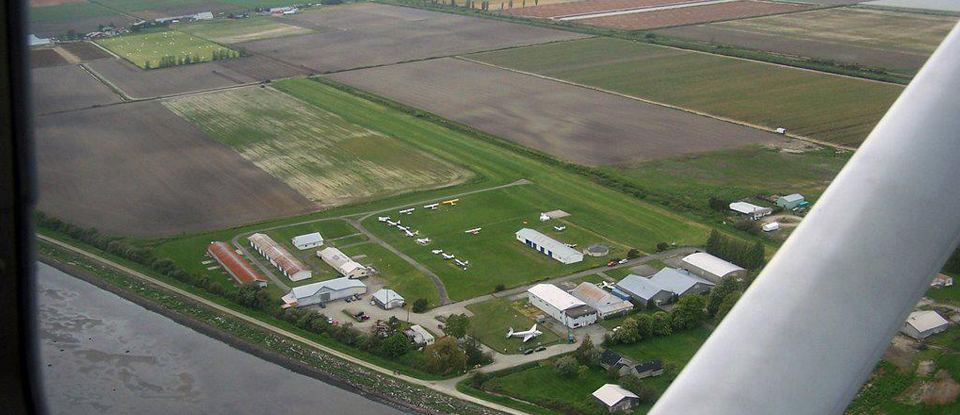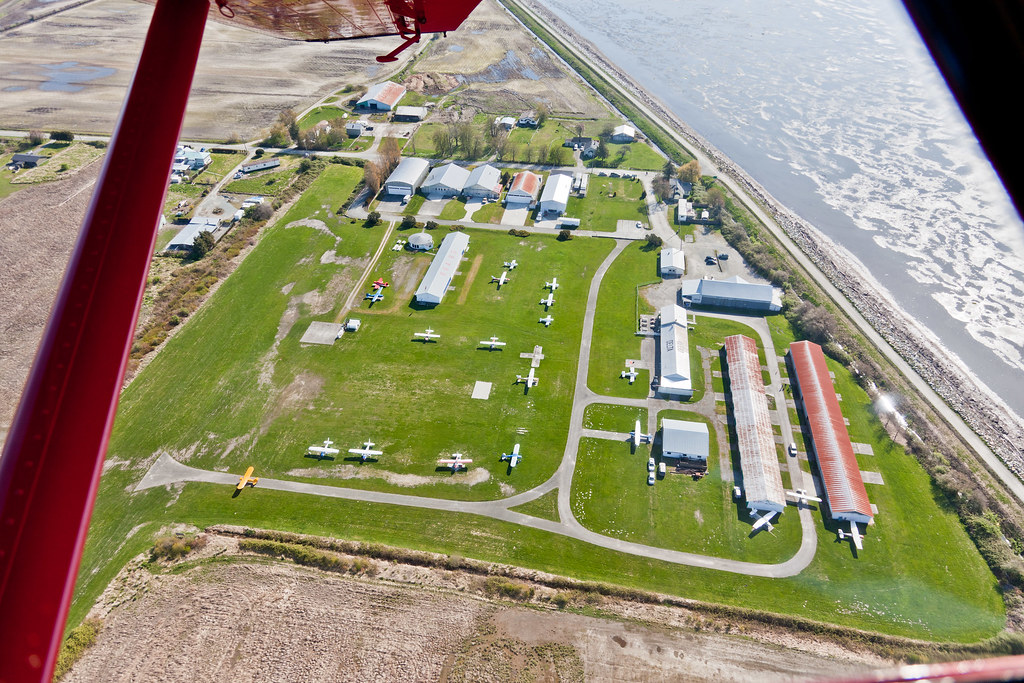In all honesty, albeit I am a licensed private pilot I can’t say that I ever harbored even as a passenger, much less as the pilot, any ambition to fly in a light aircraft however briefly, upside down or inverted to use the aviation expression. How is an inversion accomplished? As one example performing a loop will do it. A loop is when the pilot pulls the plane up into the vertical, continues around until it becomes inverted and then heads back down ultimately continuing forward in the same (original) direction, like making a 360 degree turn, except it is in the vertical plane instead of the horizontal.
As a child in the UK, I built balsa wood flying model aircraft from kits and very soon decided I wanted to learn to fly real aircraft. Thus as an adult in my early twenties, after having emigrated to Canada in 1967 and settled in Vancouver, within a few weeks of arriving I took lessons flying Fleet Canucks, Canadian designed and built tail draggers * in total 225 of which were built between 1945 and 1947. The flying school operated out of Pitt Meadows airport close to and east of Vancouver. I passed the private flying license test on the second attempt ** subsequently and quite some considerable time afterwards enjoying flying, along with a couple of co-owners, an aging if not exactly antique Aeronca Champion or colloquially, ‘Champ’ *** which we kept at Delta Heritage Airpark just south of Vancouver. Also flying out of the airpark replete with its grass and hence ‘landing forgiving’ runway, as opposed to a paved one on which one might bounce landing too heavily, was a friend I knew from sailing, an ex-Canadian air force pilot who owned a Harvard, a US and Canadian air force high performance training aircraft, high performance that is by propellor not jet standards.
The Harvard cruises at 205 mph v.s. 85 mph for the Champ. To put it mildly the difference in performance of our two aircraft was as chalk is to cheese or better yet Chevy to Maserati. Long in production, the Harvard was used to train US and Canadian military pilots. The first flight was April 1st 1935! My friend invited me one day to join him for about a one hour flight. He didn’t have to ask me twice. The Champ not having an electric starter, he had taught my co-owners and I how to safely start our Champ’s engine by manually swinging the prop **** counter clockwise. I doubt one could hand start a Harvard’s engine and live to tell about it. Very powerful indeed they of course have electric starters.
With the Harvard’s tandem cockpit canopy open, I climbed into the rear seat, settled down and went to fasten the seat belt. I couldn’t do it. Compared to those in the Champ it was complexity gone mad. It had to be in order to withstand the G forces the powerful engine could impose upon it and on an unwitting seat occupant. My pilot buddy helped me out with fastening the seatbelt and I felt I was quite literally a piece of the airplane’s structure. No way was I going anywhere. He climbed into the forward seat, closed the canopy, buckled his seat belt, started the engine, warmed it up to it’s flight temperature and there not being any other traffic waiting to take off or on a landing final approach, ***** we or rather he taxied onto the grass runway, opened the throttle fully and took off if not to fanfare certainly to a lot of noise. Once airborne he retracted the drag inducing undercarriage such aerodynamic ‘luxury’ not being a feature of our fixed undercarriage Champ.
We flew east as far as Abbotsford in the Fraser Valley about forty five miles from Vancouver and for the record the location of Canada’s major annual air show. It didn’t take us long and I got to take the controls for a while managing to keep us straight and level. After choosing a location well clear of the Abbotsford airport, over the intercom my pilot asked, of course via the headsets, if I was up for some aerobatics? Sure I said re-tightening my seat belt. No worries bring them on.
There are two kinds of loops. Inside and outside. The former and by far the most common one is initiated by applying full power, pulling the joy stick back, holding it there and climbing very steeply, The latter is rarely done and for good reason. ******* It is initiated first by diving and is generally done at some considerable altitude of course for safety reasons, not that any aerobatics are likely to be done at a low altitude. We did an inside loop the experience and other maneuvers following it, all being firsts for me. I had complete trust in my friend’s well honed skills, I knew any aerobatic maneuver he made, would be activated and completed with incredible smoothness and safety which they were albeit trying to follow the sequences and determine up from down proved to be quite the challenge for me. We completed various and sundry ‘routine’ aerobatic maneuvers my stalwart pilot friend being more than well versed having performed the various maneuvers over many years. Satisfied, we headed back to Delta.
Closing in on the Delta airpark we joined the circuit and my expert pilot very soon had us on final approach to the grass runway and to a very smooth landing. As for the aerobatics? I couldn’t have enjoyed them more however I never developed even an incipient hankering to learn how to perform them myself. Interestingly, although the Aeronca Champ was very much a conventional and popular light aircraft for its time, Aeronca did in fact build an aerobatic, as in very beefed up version of it which they called the Citabria. Like its non aerobatic stable mate, it is a single engine, tandem cockpit, fixed undercarriage aircraft. It entered production in the United States in 1964. Designed for training and personal recreational flying use, it is capable of sustaining aerobatic stresses from +5g to -2g. Its name, Citabria is of course airbatic spelled backwards!
Some time after my aerobatic adventure, whilst preparing for take off in the Champ, my flying friend and I crossed tracks he of course in the Harvard. He was immediately ahead of me and next in the line up for take off at Delta. He taxied onto the runway, opened the throttle, accelerated to take off speed and lifted off as I watched with perhaps just a twinge of envy. I then moved into position for take off, opened my throttle to full and proceeded down the runway at a fraction of the Harvard’s speed. To no surprise, I lifted off much further down the runway than had my buddy. What could only have been seconds after lift off, the Aeronca suddenly rolled quite violently to port, i.e. to the left. With very little altitude gained, I instinctively wrenched the joy stick briefly hard to starboard fearing that the port wing tip might hit the ground and then, having leveled out, continued to climb as usual maintaining full power.
I have no idea by how much my port wing tip cleared the ground at that point just barely having lifted off or for that matter, by how much the starboard wing tip then cleared it after I instinctively opposite rolled back some. Luckily both tips did stay clear of the ground or perhaps I might not be writing this. I continued the climb out to the airpark’s circuit height of six hundred feet and then elected to continued to climb for some distance yearning for the comparative safety of altitude in case something became amiss after the incident on take off. Short of it having been if unlikely a passing whirlwind, I figured that perhaps I had encountered the Harvard propeller’s take off vortex presumably twisting and swirling through the air counter clockwise as I encountered it.******* A lesson learned. Don’t take off too soon behind a very powerful engine/propellor combination especially when flying a relatively light weight aircraft which the Aeronca Champ certainly is. Oy Vay. I flew around for a while with no nondescript incidents and eventually landed back at home base with no issues.
I have many happy memories of flying out of the Delta Heritage Airpark which has its challenges. The delightful grass runway is essentially east west in orientation. Landing as one does into the wind, mostly that meant landing east to west. Located directly on final approach just to the east of the runway threshold and quite high was a large barn. ********* To give it a wide vertical berth one had to approach seriously high over it. To then avoid landing a long way down the runway, after passing the barn I would forward slip ******** to quickly reduce altitude. This often meant flying directly into the setting sun as one crabbed simultaneously forward and sideways. The Champ’s very aged, scratched to hell in a hand basket, for sure original perspex cockpit canopy was hard to see out of under those condition so guess what? I opened the window to my left and leaned out as far as I could. It worked. Just prior to touchdown I leaned back in, straightened her up and slowly sank onto the grass.
A side slip as opposed to a forward slip incidentally is defined as slipping the aircraft sideways through the air during a cross wind landing. If the wind is coming from the right, you would position your ailerons into the wind. A forward slip on the other hand (which I made many times) is used to rapidly lose altitude and provides a forward path towards one’s targeted runway landing spot.
* An undercarriage with two wheels close to the nose and one wheel close to the tail of the aircraft. This as opposed to a tricycle undercarriage. (all the wheels up front like that of an airliner)
** The test instructor noted the first time that the field I had told him I would approach for a quasi (i.e. no touch down) emergency landing approach was full of cows! Silly me. My private flying license by the way specifies ‘single engine land’ i.e. no floatplanes, no multi engines.
*** Read at www.barrydevonald.com May 7,2022 about the Delta Air Park’s then manager’s fiasco centric destruction of our Champ. The story is called Aircraft Down.
**** Viewed from the front, in North America propellers rotate counter clockwise. In the UK they rotate clockwise. I know. Go figure.
***** There is to this day, no control tower at Delta Air Park nor is one needed. Certainly at the much more active fairly nearby Pitt Meadows airport there was and is.
****** It is of course possible the shifting swirling air mass could have been a natural occurrence however that does seem unlikely. I don’t believe there was much wind at the time and I am pretty sure any wind there was originated dead ahead but I could be wrong.
******* Outside loop. It is definitely possible and most airplanes will take the negative-g forces. The limiting factor, however, is the pilot. The pilot will often “red-out” and lose control before finishing the maneuver!
******** A way of losing altitude quickly within a very short distance.
********* The barn is visible in the bottom photo. It is the one standing alone. Note the right hand side of the roof is rusted, the left is not. It is in a direct line with the runway. A yellow aircraft is approaching the runway for take off. An easy way to remember the difference between the two slips is: Side slips are used traveling sideways through the air during a crosswind landing. Forward slips are used to lose altitude quickly and take one forward towards the runway.
A total of 20,110 Harvards were built between 1938 and 1954, 3,370 0f them in Canada. Countless numbers of privately owned Harvards are still flying today.
Harvard fuel capacity: The T-6 has 110 (US) gallons on all models except the T-6G and Harvard MK 1V, which have 140 gallons. With a cruise fuel burn of 30 GPH, 110 gallons is adequate for most operators.
| Harvard First Flight (NA-49) 1st April 1935. | |
| Span: | 42 feet 1/4 inch |
| Length: | 28 feet 11-7/8 inches |
| Seating: | Tandem |
| Power plant: | Pratt & Whitney Wasp R-1340-AN-1 550 horsepower (later uprated), air-cooled |
| Speed: | 205 mph at 5,000 feet |
| Crew: | Pilot, co-pilot |
| Landing gear: | Retractable |
| Propeller: | Controllable pitch |
Fleet Canuck: A light (710 lb v.s. 4,000 lb for the Harvard) two-seater training and utility aircraft designed and manufactured in Canada and produced from 1945 to 1949. Based on a Noury N-75 prototype designed by J. Omer Noury at Stoney Creek, Ontario in 1944. Fleet Aircraft Limited acquired design rights in 1945, producing 198 aircraft from 1945 to 1947.
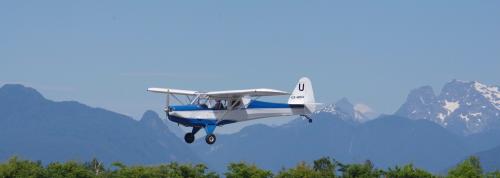
Introduced in 1945, the 7AC Champion (“Champ”) was the first (and, by far, the most popular) version of the design. It used the Continental A-65-8 engine of 65 horsepower (48 kW). (Other 65-hp engines by Lycoming and Franklin were also fitted.)
Harvard. It is estimated there are currently around 500 still flying.
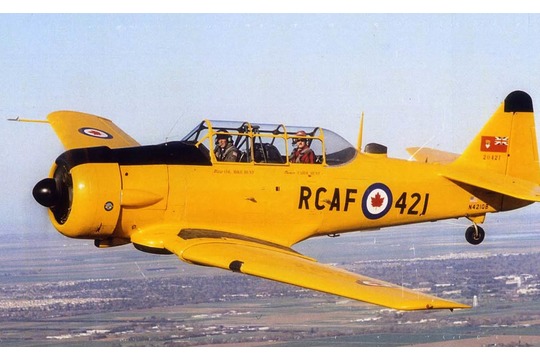
Aeronca Champ
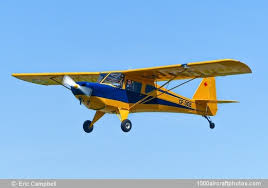
Pitt Meadows, BC airfield and Fraser River. Runway 26 Left
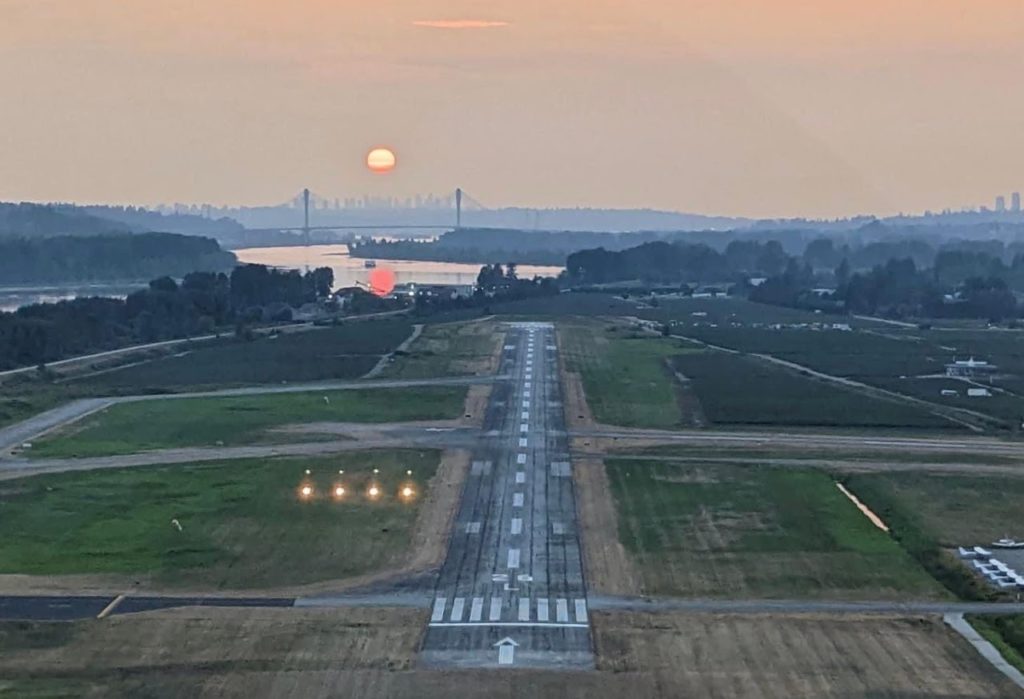
Delta Heritage airpark. Note the ocean at bottom left and upper right on the lower photo
